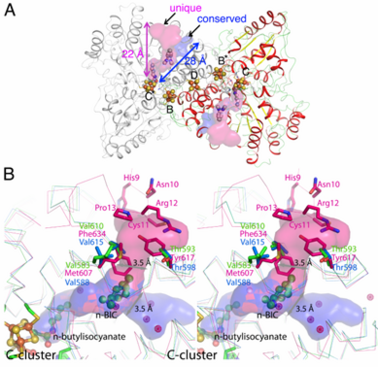Journal:JBIC:13
From Proteopedia
(Difference between revisions)

| Line 9: | Line 9: | ||
<scene name='Journal:JBIC:13/Cv1/3'>The n-BIC molecule is located in a distance of approximately 8 A from the n-butylisocyanate bound in the active site, measured between nearest atoms and is placed within a hydrophobic channel</scene>, which was shown to be a binding place for Xe atoms in CODH/ACS ([[2z8y]]). Analysis of the CODH-II structure identified the presence of two different channels (see below), in which one is analogous to the channel identified by Xe-soaking in bifunctional CODH/ACS (conserved channel), while the other seems to be specific for monofunctional CODH (unique channel). The conserved channel in CODH-II is similar in position to that in bifunctional CODH, where the channel is extended to reach the A-cluster of ACS. Monofunctional CODHs have smaller side chains like Thr and Val, while Tyr617 and Phe634 block a passage of the unique channel to the protein surface in bifunctional CODH/ACS. Furthermore, the unique channel is completely blocked by residue His9 – Pro13 to prevent diffusion of gaseous substrate/product from the protein in bifunctional CODH/ACS. However, the channel of monofunctional CODH-II is directed towards the solvent, which is in line with its role to allow fast progress and egress of substrates and products from the active site to the outside of the enzyme, which has not been described previously. | <scene name='Journal:JBIC:13/Cv1/3'>The n-BIC molecule is located in a distance of approximately 8 A from the n-butylisocyanate bound in the active site, measured between nearest atoms and is placed within a hydrophobic channel</scene>, which was shown to be a binding place for Xe atoms in CODH/ACS ([[2z8y]]). Analysis of the CODH-II structure identified the presence of two different channels (see below), in which one is analogous to the channel identified by Xe-soaking in bifunctional CODH/ACS (conserved channel), while the other seems to be specific for monofunctional CODH (unique channel). The conserved channel in CODH-II is similar in position to that in bifunctional CODH, where the channel is extended to reach the A-cluster of ACS. Monofunctional CODHs have smaller side chains like Thr and Val, while Tyr617 and Phe634 block a passage of the unique channel to the protein surface in bifunctional CODH/ACS. Furthermore, the unique channel is completely blocked by residue His9 – Pro13 to prevent diffusion of gaseous substrate/product from the protein in bifunctional CODH/ACS. However, the channel of monofunctional CODH-II is directed towards the solvent, which is in line with its role to allow fast progress and egress of substrates and products from the active site to the outside of the enzyme, which has not been described previously. | ||
| - | [[Image:IM.png|left|378px|thumb|(A) Channels in monofunctional CODH-II<sub>''Ch''</sub>. The channel into which the alkyl group of n-BIC is directed, shown in < | + | [[Image:IM.png|left|378px|thumb|(A) Channels in monofunctional CODH-II<sub>''Ch''</sub>. The channel into which the alkyl group of n-BIC is directed, shown in <span style="color:pink;background-color:black;font-weight:bold;">pink color</span>, is unique to monofunctional CODHs. <font color='blue'><b>Blue space-filling model shows the channel found in both mono- and bi-functional CODHs.</b></font> (B) Comparison of channels in mono- (CODH-II<sub>''Ch''</sub> in <span style="color:green;background-color:black;font-weight:bold;">green</span> from this study and CODH from ''Rhodospirillum rubrum'' in <span style="color:cyan;background-color:black;font-weight:bold;">cyan</span> ([[1jqk]])) and bi-functional (CODH from ''Moorella thermoacetica'' in <span style="color:pink;background-color:black;font-weight:bold;">pink</span> from PDB-ID [[2z8y]]) CODHs. <span style="color:pink;background-color:black;font-weight:bold;">Pink-colored dots</span> are Xenon atoms found in CODH from ''Moorella thermoacetica''.]] |
</StructureSection> | </StructureSection> | ||
Revision as of 14:32, 21 May 2015
| |||||||||||
- ↑ Jeoung JH, Dobbek H. n-Butyl isocyanide oxidation at the [NiFe(4)S (4)OH ( x )] cluster of CO dehydrogenase. J Biol Inorg Chem. 2011 Sep 9. PMID:21904889 doi:10.1007/s00775-011-0839-y
This page complements a publication in scientific journals and is one of the Proteopedia's Interactive 3D Complement pages. For aditional details please see I3DC.

